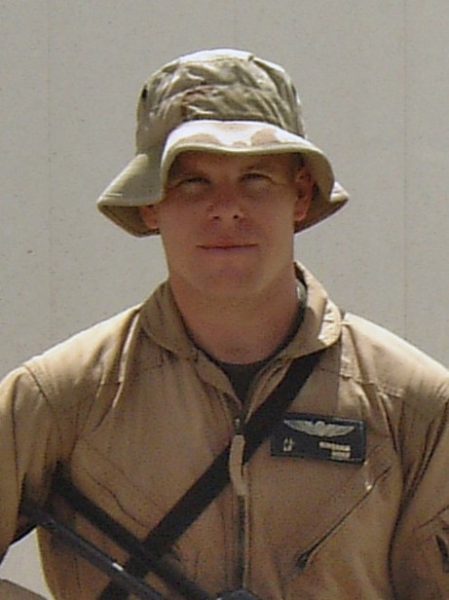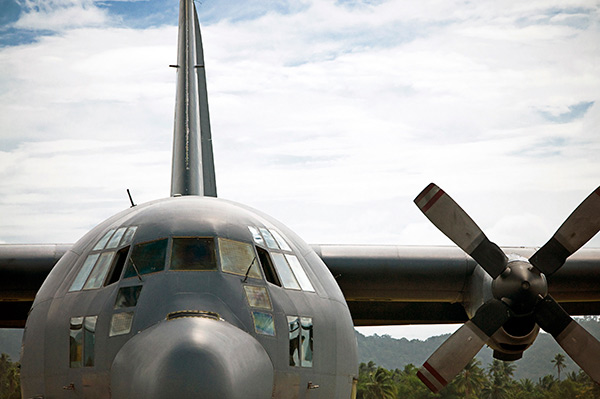The tightly woven fabric of uniforms, plus gloves, helmets, sunglasses and sunscreen, help protect U.S. Army paratroopers on the ground. Photos, top and bottom: iStock/Getty Images Plus
The brave men and women who serve our country know they accept some risks, but they may not know that one of them is skin cancer. We asked Jonathan L. Bingham, MD, a Mohs surgeon in Great Falls, Montana, and the State Air Surgeon for the Montana Air National Guard, to tell us more about this danger.
Q: Having served in the U.S. Navy for 24 years, including 15 years on active duty, plus almost a decade with the Montana Air National Guard, you’ve seen some diverse terrain, from desert to water to high altitude. You also spent many years as a dermatologist and chief of Mohs surgery at Walter Reed National Military Medical Center in Bethesda, Maryland. What have you learned about the risks of skin cancer in our military personnel?
Dr. Bingham: An important 2018 review article in Journal of the American Academy of Dermatology showed that, indeed, those who have served are at a greater risk of developing skin cancer than those who have not served. There wasn’t a clear consensus on that before. Since then, we’ve seen more evidence to confirm this — including convincing data in a study showing that Air Force officers have not only a greater chance of developing melanoma but also of dying from it.
The other thing that has been a game changer is that both the Department of Defense and the Department of Veterans Affairs have recognized melanoma as being an identified malignancy from burn pit exposure. That is across all branches of the military.
Other studies have looked at skin cancer rates in the military by service. The Air Force has the highest rate, in both melanoma and nonmelanoma skin cancer. If you break it down by rank, officers, especially older officers, tend to have a greater rate of melanoma and nonmelanoma skin cancers than the enlisted personnel. Finally, when you break it down by job description, there is a greater incidence of it in pilots compared with service warfare officers who spend time on board ships. The lowest incidence of skin cancer in the military is in people who are in mechanized units, the people who work with tanks and probably spend a lot of time inside the tanks. I don’t know if they looked at the submariners, but I would think the incidence would be pretty low there, too!

Brutal sun: A wide-brimmed boonie hat helped protect Dr. Bingham from the desert sun while stationed in Kuwait in 2003.
Q: I would think sun protection would be crucial in a hot desert climate. You spent time in the Middle East. What did you observe there?
Dr. Bingham: I was a flight surgeon with the 2nd Marine Aircraft Wing, and I served in Operation Iraqi Freedom in 2003. Yes, there was plenty of opportunity for sun exposure there, just given the climate. When it was operationally feasible, the military tried to outfit us in a way that would help protect us from the sun. I remember we would wear these military boonie-style hats with a wide brim. Those were helpful. Our uniforms had long sleeves in tightly woven fabric, which helps to protect skin from the sun. But only if you could stand them, because gosh, there were days when the temperature was over 120 degrees.
Q: Was sunscreen available to you, and did anyone talk about it?
Dr. Bingham: Sunscreen was talked about. One of the reasons was because doxycycline, a medication that we used for malaria prevention, makes you photosensitive, meaning you’re more apt to get a sunburn. It was not uncommon that we saw people with sunburns, and part of that was because they were on this medicine.
Sunscreen was not routinely issued, but it was available in the PX, a little general store on the base. In my case, family members sent me care packages from home that usually included sunscreens. Still, we had people who didn’t practice good sun protection. I remember one of the worst sunburns I’ve ever seen in my entire medical career was a Marine in my unit who drove an ambulance. One day he just did not put on any sunscreen or wear a hat on his completely shaven head. As a result, he had one of the worst scalp sunburns I’ve ever seen.
Q: I assume wearing a lot of equipment and protective gear as part of a uniform helps serve as a barrier to shield troops from the sun’s ultraviolet (UV) rays. But isn’t there also down time and the temptation to bask in the sun a little, like we’ve seen in movies?
Dr. Bingham: During World War II, and in Vietnam, it was pretty commonplace to take off your shirt and get a tan — if the commanding officer allowed it. I think you don’t see that aspect of the military as much now. I don’t remember ever seeing someone walking around our base in the Middle East without a shirt on. That might have been acceptable many years ago but certainly not in today’s military.
Q: Did you spend much time shipboard? It seems like being out on the water with lots of sun, reflection and little shade would be a recipe for sunburn.
Dr. Bingham: During all my years in the Navy, I think I spent a grand total of eight weeks at sea! When I wasn’t assigned to Bethesda and did operational medicine, I was usually stationed with the Marines, land-based somewhere. But I did spend a short period of time on a guided missile cruiser based out of Washington. And I did my undergrad work at the Naval Academy in Annapolis, where we learned how to sail. The amount of sun exposure you can get out on the water is incredible, especially if you’re outside on watch on the deck of the ship. But it is my understanding, in talking to a colleague who spent a lot of time on ships, that they’re very mindful of that now. Sunscreen is encouraged and readily available, as is wearing protective clothing and sunglasses on board the ships. This holds true for anyone just out having fun on a boat, too, of course!
Q: We know that pilots, whether private, commercial or in the military, are exposed to dangerous UV radiation at high altitude in flight. As a flight surgeon, what did you experience while spending a lot of time in the air?
Dr. Bingham: While there are a lot of flight surgeons who are what we call “dual designated,” meaning they are also pilots, I was purely a flight surgeon. And while I did have the opportunity to fly, my primary job was patient care. I did get a lot of flight time in the HH-46 helicopter as well as the C-9 Greyhound. Now I get to fly in the C-130 as a member of the Montana Air National Guard, and some of those aircraft are 60 years old.
Today a lot of the more modern military aircraft cockpits are designed to protect pilots from more of the UV radiation exposure. We will be getting brand-new C-130 aircraft, and both the cockpit design and the materials that are used to construct the windows are more UV protective. But while we’re still flying older aircraft, those pilots need to use sun protection. They can’t wear a boonie-style hat because of the headphones they have to wear. So I recommend that all of my pilots and aviators wear baseball caps, sunglasses and sunscreen as well. In fact, I give an annual skin cancer briefing every year to all the pilots. Pilots who aren’t in the military should also protect themselves while in the air.

Danger in the cockpit: Military pilots need to protect themselves from UV radiation while flying, especially in older aircraft like the C-130.
Q: Speaking of altitude, you’re currently practicing in Montana. What do people need to know about the risks of skin cancer while in the mountains?
Dr. Bingham: Mountain altitude is certainly an issue. There’s a group called the 10th Mountain Division. They were the skiing soldiers of World War II, and the unit is still trained to fight in mountainous and arctic conditions. These individuals also have a fairly high rate of skin cancer. I have seen many of the 10th Mountain Soldiers as patients over the years. They are incredible veterans to speak with and get to know.
Levels of ultraviolet radiation increase by 3 to 5 percent for each 1,000-foot increase in altitude. Skiers and hikers need to understand this risk, too. I did my Mohs surgery fellowship at the University of Colorado Medical Center, and I was assigned to the ROTC unit at Boulder. The amount of skin cancer I saw that year was incredible. Montana is the same way. People just love being outdoors, and they need to protect themselves all year long.
Q: How would you answer a parent with a family history of skin cancer asking, “I’m worried about my kids getting too much sun exposure in the military. Is there anything I can do?”
Dr. Bingham: I would say, “I strongly suggest you frequently send them a care package with a lot of sunscreen in it.” Unfortunately, sunscreen is generally not issued gear. The typical age of someone who is serving in the military is younger than 25. At that age, they feel like they’re invincible, that there are more important things to buy than sunscreen and more important things to do than use sunscreen.
If they are going to serve in an area that’s closer to the equator, on water, in the air or at a high altitude, they certainly have to be concerned about that and wear as much protective clothing as possible. Our military is more diverse today, and everyone of every skin tone is at risk. I am grateful that the military recognizes the risks and is taking more measures to encourage everyone to protect themselves from the sun. And if there is an option to do required outdoor work in the shade instead of in the sun, they’re going to do that because it makes sense for the welfare and health of our Soldiers, Sailors, Airmen and Marines.
About the expert:
 Jonathan L. Bingham, MD, is a dermatologist and Mohs surgeon in Great Falls, Montana. He served in the U.S. Navy as a flight surgeon and Mohs surgeon-dermatologist, including at the National Naval Medical Center and Walter Reed National Military Medical Center in Bethesda, Maryland. He also supported the White House Medical Unit and the Office of the Attending Physician. He is currently serving as State Air Surgeon for the Montana Air National Guard.
Jonathan L. Bingham, MD, is a dermatologist and Mohs surgeon in Great Falls, Montana. He served in the U.S. Navy as a flight surgeon and Mohs surgeon-dermatologist, including at the National Naval Medical Center and Walter Reed National Military Medical Center in Bethesda, Maryland. He also supported the White House Medical Unit and the Office of the Attending Physician. He is currently serving as State Air Surgeon for the Montana Air National Guard.





